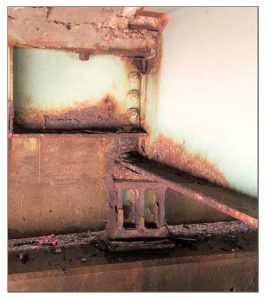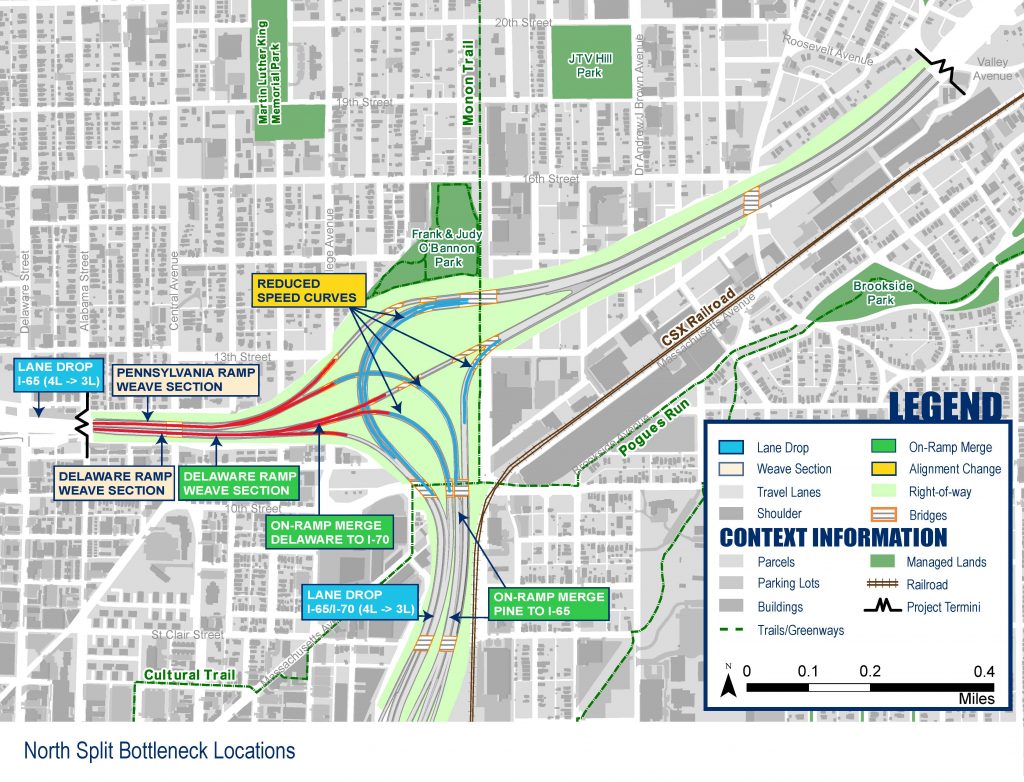CORRECT BRIDGE CONDITIONS
 Correct deteriorated I-65/I-70 North Split bridge conditions
Correct deteriorated I-65/I-70 North Split bridge conditions
INDOT inspects bridges every two years. The most recent bridges inspections in the North Split project area revealed wear caused by:
- Continuous use by large traffic volumes
- Weather-related deterioration over a long time
Of the 31 bridges in the project area, 27 are estimated to have less than 10 years of remaining service life before major repairs or reconstruction are needed:
- 11 structures have less than 5 years of life
CORRECT PAVEMENT CONDITIONS
Correct the deteriorated pavement conditions on the interstates within the I-65/I-70 North Split project area
Most portions of the North Split interchange were constructed in 1968, and the pavement is past its life expectancy.
- Pavement’s surface has become “polished,” which reduces friction for vehicles
- Tests indicate that project area pavement has low friction values, which increase skidding when wet
- Mainline pavement exceeds the threshold for the International Roughness Index used to measure ride quality
Frequent patching is required to repair cracks and holes in the mainline concrete pavement, especially along I-65/I-70 south of the North Split. These types of maintenance operations often require lane closures and cause traffic delays in the North Split project area.
The asphalt shoulders are in poor condition and are starting to oxidize, which is a process where pavement becomes brittle and cracks.
IMPROVE SAFETY
Improve safety by reducing or eliminating conditions that result in crashes along I-65 and I-70
There were more than 1,600 crashes in the North Split project area between 2012 and 2016. Crash rates are higher than average for urban interstates:
- 1.8 X higher fatalities
- 2.8 X higher personal injury
- 2.3 X higher property damage
The top four crash sites – around 20% of crashes in the North Split – were:
- I-65 northbound at Meridian/Pennsylvania Street exit ramp, west leg of North Split
- I-65 southbound at Meridian/Delaware Street entrance ramp, west leg of North Split
- I-65 southbound and I-70 westbound merge point on south leg
- I-70 eastbound, abrupt curve from south leg to east leg
The highest number of crashes are on the west leg of the interchange, in weaving areas.

IMPROVE OPERATIONS AND REDUCE CONGESTION
Improve interchange operations and reduce congestion by removing weaving sections and improving level of service now and in 2041
Interchange operations are affected by:
- High traffic volumes
- Substandard design features
- Merge areas where lanes join together
- Weaving areas where traffic movements cross each other
Bottlenecks include weaves and tight curves, which cause congestion and increased travel times. The project will remove bottlenecks and improve level of service now and in 2041.
Level of Service (LOS) describes the degree of traffic congestion on roadways, using “grades” on a letter scale from LOS A (best) to LOS F (worst). Many sections in the project area operate at LOS E or F during peak hours of travel. With no changes to the configuration of the interchange, 2041 operations will drop to LOS F on many more movements.

